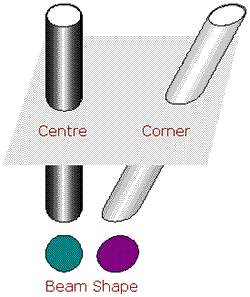A CRTs electron beam focusing circuitry has to change the focal length of an electrostatic or electromagnetic “lens” according to where on the screen the beam is being directed, as shown in Dynamic Focus . This ensures that the beam is consistently focused on a spot of the correct size on the inside of the faceplate. If the spot is too large, it may spill over into the next screen pixel location; too small and the pixel brightness is reduced. For similar reasons, the shape of the beam should also remain the same, whether it strikes the centre or the corner of the CRT faceplate.
However, the varying angle at which the beam meets the faceplate, and the constantly changing strength and duration of the influence the deflection yoke and anode have on the beam, mean that a perfectly shaped spot at the screen centre will become increasingly distorted as it is moved towards the edge or corner of the screen. To overcome this tendency, more electrodes can be added to the focusing assembly to pre-warp the beam into a cross-section which, once it has been distorted by the deflection yoke and anode magnetic fields, forms a spot close to the correct shape, wherever it lands on the screen. This process is known as dynamic beam forming.

